NSC COP8FGR7VEJ8, COP8FGR744V8, COP8FGR740N8, COP8FGR728N8, COP8FGR728M8 Datasheet
...
July 1999
COP8FG Family
8-Bit CMOS ROM Based and OTP Microcontrollers with 8k to 32k Memory, Two Comparators and USART
General Description
Note: COP8FG devices are 15 MHz versions of the COP8SG devices.
The COP8FGx5 Family ROM based microcontrollers are highly integrated COP8™ Feature core devices with 8k to 32k memory and advanced features including Analog comparators, and zero external components. These single-chip CMOS devices are suited for more complex applications requiring a full featured controller with larger memory, low EMI, two comparators, and a full-duplex USART. COP8FGx7 devices are 100% form-fit-function compatible 8k or 32k OTP (One Time Programmable) versions for use in production or development.
Erasable windowed versions are available for use with a range of COP8 software and hardware development tools.
Family features include an 8-bit memory mapped architecture, 15 MHz CKI with 0.67 µs instruction cycle, 14 interrupts, three multi-function 16-bit timer/counters with PWM, full duplex USART, MICROWIRE/PLUS™ , two analog comparators, two power saving HALT/IDLE modes, MIWU, idle timer, on-chip R/C oscillator, high current outputs, user selectable options (WATCHDOG™ , 4 clock/oscillator modes, power-on-reset), 4.5V to 5.5V operation, program code security, and 28/40/44 pin packages.
Devices included in this datasheet are:
Device |
Memory (bytes) |
RAM |
I/O Pins |
Packages |
Temperature |
|
(bytes) |
||||||
|
|
|
|
|
||
COP8FGE5 |
8k ROM |
256 |
24/36/40 |
28 DIP/SOIC, 40 DIP, 44 PLCC/QFP |
-40 to +85ÊC |
|
COP8FGG5 |
16k ROM |
512 |
24/36/40 |
28 DIP/SOIC, 40 DIP, 44 PLCC/QFP |
-40 to +85ÊC |
|
COP8FGH5 |
20k ROM |
512 |
24/36/40 |
28 DIP/SOIC, 40 DIP, 44 PLCC/QFP |
-40 to +85ÊC |
|
COP8FGK5 |
24k ROM |
512 |
24/36/40 |
28 DIP/SOIC, 40 DIP, 44 PLCC/QFP |
-40 to +85ÊC |
|
COP8FGR5 |
32k ROM |
512 |
24/36/40 |
28 DIP/SOIC, 40 DIP, 44 PLCC/QFP |
-40 to +85ÊC |
|
COP8FGE7 |
8k OTP EPROM |
256 |
24/36/40 |
28 DIP/SOIC, 40 DIP, 44 PLCC/QFP |
-40 to +85ÊC |
|
COP8FGR7 |
32k OTP EPROM |
512 |
24/36/40 |
28 DIP/SOIC, 40 DIP, 44 PLCC/QFP |
-40 to +85ÊC |
|
COP8FGR7-Q3 |
32k EPROM |
512 |
24/36/40 |
28 DIP/SOIC, 40 DIP, 44 PLCC/QFP |
Room Temp. |
|
|
|
|
|
|
|
Key Features
nLow cost 8-bit microcontroller
nQuiet Design (low radiated emissions)
nMulti-Input Wakeup pins with optional interrupts (8 pins)
nMask selectable clock options
ÐCrystal oscillator
ÐCrystal oscillator option with on-chip bias resistor
ÐExternal oscillator
ÐInternal R/C oscillator
nInternal Power-On-Reset Ð user selectable
nWATCHDOG and Clock Monitor Logic Ð user selectable
nEight high current outputs
n256 or 512 bytes on-board RAM
n8k to 32k ROM or OTP EPROM with security feature
CPU Features
nVersatile easy to use instruction set
n0.67 µs instruction cycle time
nFourteen multi-source vectored interrupts servicing
ÐExternal interrupt / Timers T0 Ð T3
ÐMICROWIRE/PLUS Serial Interface
ÐMulti-Input Wake Up
ÐSoftware Trap
ÐUSART (2; 1 receive and 1 transmit)
ÐDefault VIS (default interrupt)
n8-bit Stack Pointer SP (stack in RAM)
nTwo 8-bit Register Indirect Data Memory Pointers
nTrue bit manipulation
nBCD arithmetic instructions
Peripheral Features
nMulti-Input Wakeup Logic
nThree 16-bit timers (T1 Ð T3), each with two 16-bit registers supporting:
ÐProcessor Independent PWM mode
ÐExternal Event Counter mode
ÐInput Capture mode
nIdle Timer (T0)
nMICROWIRE/PLUS Serial Interface (SPI Compatible)
nFull Duplex USART
nTwo Analog Comparators
COP8™ , MICROWIRE/PLUS™ , and WATCHDOG™ are trademarks of National Semiconductor Corporation. TRI-STATE® is a registered trademark of National Semiconductor Corporation.
iceMASTER® is a registered trademark of MetaLink Corporation.
Two Memory, 32k to 8k with Microcontrollers OTP and Based ROM CMOS Bit-8 Family, COP8FG
USART and Comparators
© 1999 National Semiconductor Corporation |
DS101116 |
www.national.com |
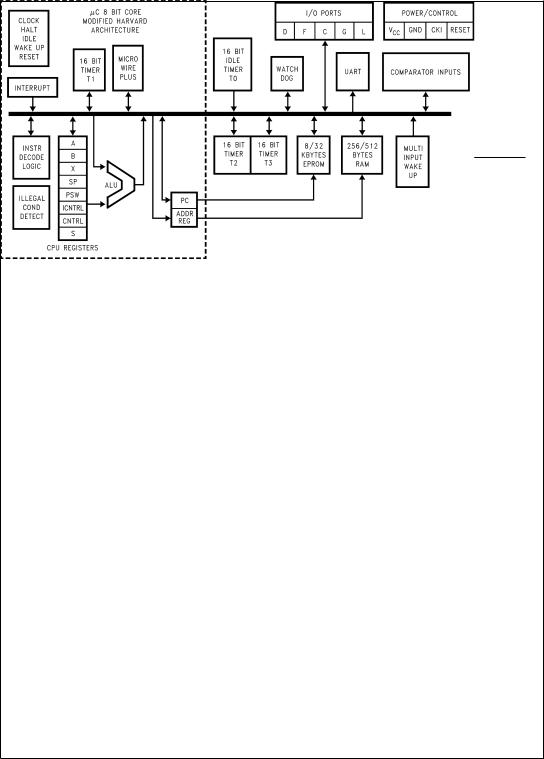
I/O Features
nSoftware selectable I/O options (TRI-STATE® Output,Push-Pull Output, Weak Pull-Up Input, and High Impedance Input)
nSchmitt trigger inputs on ports G and L
nEight high current outputs
nPackages: 28 SO with 24 I/O pins, 40 DIP with 36 I/O pins, 44 PLCC and PQFP with 40 I/O pins
Fully Static CMOS Design
nLow current drain (typically < 4 µA)
nTwo power saving modes: HALT and IDLE
Temperature Range
n −40ÊC to +85ÊC
Development Support
nWindowed packages for DIP and PLCC
nReal time emulation and full program debug offered by MetaLink Development System
Block Diagram
DS101116-44
FIGURE 1. COP8FGx Block Diagram
www.national.com |
2 |

1.0Device Description
1.1ARCHITECTURE
The COP8 family is based on a modified Harvard architecture, which allows data tables to be accessed directly from program memory. This is very important with modern microcontroller-based applications, since program memory is usually ROM or EPROM, while data memory is usually RAM. Consequently data tables need to be contained in non-volatile memory, so they are not lost when the microcontroller is powered down. In a modified Harvard architecture, instruction fetch and memory data transfers can be overlapped with a two stage pipeline, which allows the next instruction to be fetched from program memory while the current instruction is being executed using data memory. This is not possible with a Von Neumann single-address bus architecture.
The COP8 family supports a software stack scheme that allows the user to incorporate many subroutine calls. This capability is important when using High Level Languages. With a hardware stack, the user is limited to a small fixed number of stack levels.
1.2 INSTRUCTION SET
In today's 8-bit microcontroller application arena cost/ performance, flexibility and time to market are several of the key issues that system designers face in attempting to build well-engineered products that compete in the marketplace. Many of these issues can be addressed through the manner in which a microcontroller's instruction set handles processing tasks. And that's why COP8 family offers a unique and code-efficient instruction set Ð one that provides the flexibility, functionality, reduced costs and faster time to market that today's microcontroller based products require.
Code efficiency is important because it enables designers to pack more on-chip functionality into less program memory space. Selecting a microcontroller with less program memory size translates into lower system costs, and the added security of knowing that more code can be packed into the available program memory space.
1.2.1 Key Instruction Set Features
The COP8 family incorporates a unique combination of instruction set features, which provide designers with optimum code efficiency and program memory utilization.
Single Byte/Single Cycle Code Execution
The efficiency is due to the fact that the majority of instructions are of the single byte variety, resulting in minimum program space. Because compact code does not occupy a substantial amount of program memory space, designers can integrate additional features and functionality into the microcontroller program memory space. Also, the majority instructions executed by the device are single cycle, resulting in minimum program execution time. In fact, 77% of the instructions are single byte single cycle, providing greater code and I/O efficiency, and faster code execution.
1.2.2 Many Single-Byte, Multifunction Instructions
The COP8 instruction set utilizes many single-byte, multifunction instructions. This enables a single instruction to accomplish multiple functions, such as DRSZ, DCOR, JID, LD (Load) and X (Exchange) instructions with post-incrementing and post-decrementing, to name just a few examples. In
many cases, the instruction set can simultaneously execute as many as three functions with the same single-byte instruction.
JID: (Jump Indirect); Single byte instruction; decodes external events and jumps to corresponding service routines (analogous to ªDO CASEº statements in higher level languages).
LAID: (Load Accumulator-Indirect); Single byte look up table instruction provides efficient data path from the program memory to the CPU. This instruction can be used for table lookup and to read the entire program memory for checksum calculations.
RETSK: (Return Skip); Single byte instruction allows return from subroutine and skips next instruction. Decision to branch can be made in the subroutine itself, saving code.
AUTOINC/DEC: (Auto-Increment/Auto-Decrement); These instructions use the two memory pointers B and X to efficiently process a block of data (analogous to ªFOR NEXTº in higher level languages).
1.2.3 Bit-Level Control
Bit-level control over many of the microcontroller's I/O ports provides a flexible means to ease layout concerns and save board space. All members of the COP8 family provide the ability to set, reset and test any individual bit in the data memory address space, including memory-mapped I/O ports and associated registers.
1.2.4 Register Set
Three memory-mapped pointers handle register indirect addressing and software stack pointer functions. The memory data pointers allow the option of post-incrementing or postdecrementing with the data movement instructions (LOAD/ EXCHANGE). And 15 memory-maped registers allow designers to optimize the precise implementation of certain specific instructions.
1.3 EMI REDUCTION
The COP8FGx5 family of devices incorporates circuitry that guards against electromagnetic interference Ð an increasing problem in today's microcontroller board designs. National's patented EMI reduction technology offers low EMI clock circuitry, gradual turn-on output drivers (GTOs) and internal ICC smoothing filters, to help circumvent many of the EMI issues influencing embedded control designs. National has achieved 15 dB±20 dB reduction in EMI transmissions when designs have incorporated its patented EMI reducing circuitry.
1.4 PACKAGING/PIN EFFICIENCY
Real estate and board configuration considerations demand maximum space and pin efficiency, particularly given today's high integration and small product form factors. Microcontroller users try to avoid using large packages to get the I/O needed. Large packages take valuable board space and increases device cost, two trade-offs that microcontroller designs can ill afford.
The COP8 family offers a wide range of packages and do not waste pins: up to 90.9% (or 40 pins in the 44-pin package) are devoted to useful I/O.
3 |
www.national.com |
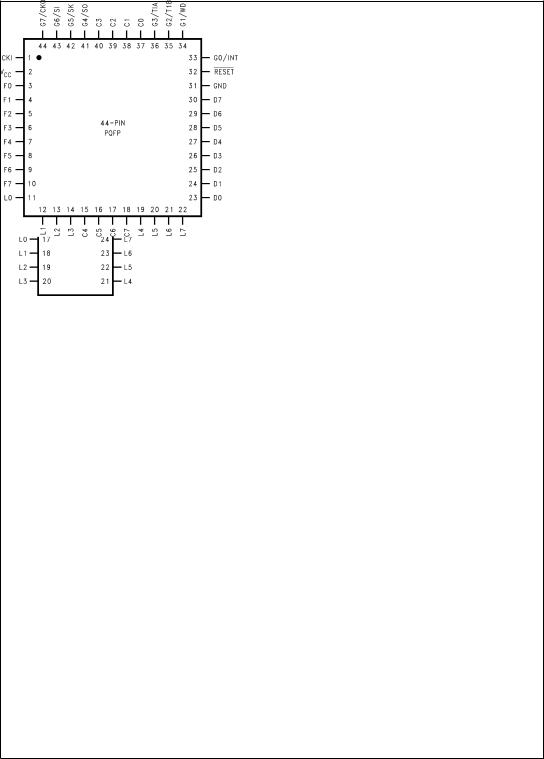
Connection Diagrams
DS101116-4
Note 1: X = E for 8k, G for 16k,
H for 20k, K for 24k, R for 32k
Y = 5 for ROM, 7 for OTP
Top View
Order Number COP8FGXY28M8
See NS Package Number M28B
Order Number COP8FGXY28N8
See NS Package Number N28A
Order Number COP8FGR728Q3
See NS Package Number D28JQ
DS101116-5
Top View
Order Number COP8FGXY40N8
See NS Package Number N40A
Order Number COP8FGR540Q3
See NS Package Number D40KQ
DS101116-6
DS101116-43
Top View |
Top View |
|
Order Number COP8FGXY44V8 |
||
Order Number COP8FGXYVEJ8 |
||
See NS Package Number V44A |
||
See NS Package Number VEJ44A |
||
Order Number COP8FGR744J3 |
||
|
||
See NS Package Number EL44C |
|
|
FIGURE 2. Connection Diagrams |
||
www.national.com |
4 |

Connection Diagrams (Continued)
Pinouts for 28 -, 40and 44-Pin Packages
|
Port |
Type |
Alt. Fun |
28-Pin SO |
40-Pin DIP |
44-Pin PLCC |
44-Pin PQFP |
|
|
|
|
|
|
|
|
|
|
|
L0 |
I/O |
MIWU |
11 |
17 |
17 |
11 |
|
|
L1 |
I/O |
MIWU or CKX |
12 |
18 |
18 |
12 |
|
|
L2 |
I/O |
MIWU or TDX |
13 |
19 |
19 |
13 |
|
|
L3 |
I/O |
MIWU or RDX |
14 |
20 |
20 |
14 |
|
|
L4 |
I/O |
MIWU or T2A |
15 |
21 |
25 |
19 |
|
|
L5 |
I/O |
MIWU or T2B |
16 |
22 |
26 |
20 |
|
|
L6 |
I/O |
MIWU or T3A |
17 |
23 |
27 |
21 |
|
|
L7 |
I/O |
MIWU or T3B |
18 |
24 |
28 |
22 |
|
|
|
|
|
|
|
|
|
|
|
G0 |
I/O |
INT |
25 |
35 |
39 |
33 |
|
|
G1 |
I/O |
WDOUT* |
26 |
36 |
40 |
34 |
|
|
G2 |
I/O |
T1B |
27 |
37 |
41 |
35 |
|
|
G3 |
I/O |
T1A |
28 |
38 |
42 |
36 |
|
|
G4 |
I/O |
SO |
1 |
3 |
3 |
41 |
|
|
G5 |
I/O |
SK |
2 |
4 |
4 |
42 |
|
|
G6 |
I |
SI |
3 |
5 |
5 |
43 |
|
|
G7 |
I |
CKO |
4 |
6 |
6 |
44 |
|
|
|
|
|
|
|
|
|
|
|
D0 |
O |
|
19 |
25 |
29 |
23 |
|
|
D1 |
O |
|
20 |
26 |
30 |
24 |
|
|
D2 |
O |
|
21 |
27 |
31 |
25 |
|
|
D3 |
O |
|
22 |
28 |
32 |
26 |
|
|
D4 |
O |
|
29 |
33 |
27 |
|
|
|
D5 |
O |
|
30 |
34 |
28 |
|
|
|
D6 |
O |
|
31 |
35 |
29 |
|
|
|
D7 |
O |
|
32 |
36 |
30 |
|
|
|
|
|
|
|
|
|
|
|
|
F0 |
I/O |
|
7 |
9 |
9 |
3 |
|
|
F1 |
I/O |
COMP1IN− |
8 |
10 |
10 |
4 |
|
|
F2 |
I/O |
COMP1IN+ |
9 |
11 |
11 |
5 |
|
|
F3 |
I/O |
COMP1OUT |
10 |
12 |
12 |
6 |
|
|
F4 |
I/O |
COMP2IN− |
|
13 |
13 |
7 |
|
|
F5 |
I/O |
COMP2IN+ |
|
14 |
14 |
8 |
|
|
F6 |
I/O |
COMP2OUT |
|
15 |
15 |
9 |
|
|
F7 |
I/O |
|
|
16 |
16 |
10 |
|
|
|
|
|
|
|
|
|
|
|
C0 |
I/O |
|
|
39 |
43 |
37 |
|
|
C1 |
I/O |
|
|
40 |
44 |
38 |
|
|
C2 |
I/O |
|
|
1 |
1 |
39 |
|
|
C3 |
I/O |
|
|
2 |
2 |
40 |
|
|
C4 |
I/O |
|
|
|
21 |
15 |
|
|
C5 |
I/O |
|
|
|
22 |
16 |
|
|
C6 |
I/O |
|
|
|
23 |
17 |
|
|
C7 |
I/O |
|
|
|
24 |
18 |
|
|
|
|
|
|
|
|
|
|
|
VCC |
|
|
6 |
8 |
8 |
2 |
|
|
GND |
|
|
23 |
33 |
37 |
31 |
|
|
CKI |
I |
|
5 |
7 |
7 |
1 |
|
|
|
I |
|
24 |
34 |
38 |
32 |
|
|
RESET |
|
|
|||||
* G1 operation as WDOUT is controlled by ECON bit 2.
5 |
www.national.com |
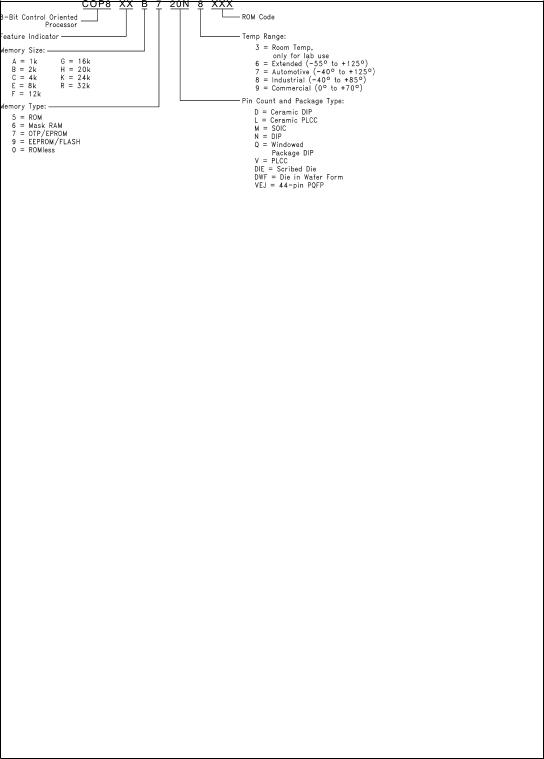
2.1 Ordering Information
DS101116-8
FIGURE 3. Part Numbering Scheme
www.national.com |
6 |

3.0 Electrical Characteristics
Absolute Maximum Ratings (Note 2)
If Military/Aerospace specified devices are required, please contact the National Semiconductor Sales Office/ Distributors for availability and specifications.
Supply Voltage (VCC) |
7V |
Voltage at Any Pin |
−0.3V to V CC +0.3V |
Total Current into VCC |
100 mA |
Pin (Source) |
Total Current out of GND |
|
Pin (Sink) |
110 mA |
Storage Temperature |
|
Range |
−65ÊC to +140ÊC |
ESD Protection Level |
2kV (Human Body Model) |
Note 2: Absolute maximum ratings indicate limits beyond which damage to the device may occur. DC and AC electrical specifications are not ensured when operating the device at absolute maximum ratings.
DC Electrical Characteristics
−40ÊC ≤ TA ≤ +85ÊC unless otherwise specified.
|
|
Parameter |
Conditions |
Min |
Typ |
Max |
Units |
|
|
|
|
|
|
|
|
|
Operating Voltage |
|
4.5 |
|
5.5 |
V |
|
|
Power Supply Rise Time |
|
10 |
|
50 x 106 |
ns |
|
VCC Start Voltage to Guarantee POR |
|
0 |
|
0.25 |
V |
||
|
Power Supply Ripple (Note 4) |
Peak-to-Peak |
|
|
0.1 Vcc |
V |
|
Supply Current (Note 5) |
|
|
|
|
|
||
|
CKI = 15 MHz |
VCC = 5.5V, tC = 0.67 µs |
|
|
9.0 |
mA |
|
|
CKI = 10 MHz |
VCC = 5.5V, tC = 1 µs |
|
|
6.0 |
mA |
|
|
CKI = 4 MHz |
VCC = 4.5V, tC = 2.5 µs |
|
|
2.1 |
mA |
|
HALT Current (Note 6) |
VCC = 5.5V, CKI = 0 MHz |
|
<4 |
10 |
µA |
||
IDLE Current (Note 5) |
|
|
|
|
|
||
|
CKI = 15 MHz |
VCC = 5.5V, tC = 0.67 µs |
|
|
2.25 |
mA |
|
|
CKI = 10 MHz |
VCC = 5.5V, tC = 1 µs |
|
|
1.5 |
mA |
|
|
CKI = 4 MHz |
VCC = 4.5V, tC = 2.5 µs |
|
|
0.8 |
mA |
|
Input Levels (VIH, VIL) |
|
|
|
|
|
||
|
|
|
|
|
|
|
|
|
RESET |
|
|
|
|
|
|
|
Logic High |
|
0.8 Vcc |
|
|
V |
|
|
Logic Low |
|
|
|
0.2 Vcc |
V |
|
CKI, All Other Inputs |
|
|
|
|
|
||
|
Logic High |
|
0.7 Vcc |
|
|
V |
|
|
Logic Low |
|
|
|
0.2 Vcc |
V |
|
Internal Bias Resistor for the |
|
0.5 |
1 |
2 |
MΩ |
||
Crystal/Resonator Oscillator |
|
|
|
|
|
||
|
|
|
|
|
|
|
|
CKI Resistance to VCC or GND when R/C |
VCC = 5.5V |
5 |
8 |
11 |
kΩ |
||
|
Oscillator is selected |
|
|
|
|
|
|
|
|
|
|
|
|
|
|
|
Hi-Z Input Leakage |
VCC = 5.5V |
−2 |
|
+2 |
µA |
|
|
Input Pullup Current |
VCC = 5.5V, VIN = 0V |
−40 |
|
−250 |
µA |
|
G and L Port Input Hysteresis |
VCC = 5.5V |
0.25 Vcc |
|
|
V |
||
Output Current Levels |
|
|
|
|
|
||
D Outputs |
|
|
|
|
|
||
|
Source |
VCC = 4.5V, VOH = 3.3V |
−0.4 |
|
|
mA |
|
|
Sink |
VCC = 4.5V, VOL = 1.0V |
10 |
|
|
mA |
|
All Others |
|
|
|
|
|
||
|
Source (Weak Pull-Up Mode) |
VCC = 4.5V, VOH = 2.7V |
−10.0 |
|
−110 |
µA |
|
|
Source (Push-Pull Mode) |
VCC = 4.5V, VOH = 3.3V |
−0.4 |
|
|
mA |
|
|
Sink (Push-Pull Mode) |
VCC = 4.5V, VOL = 0.4V |
1.6 |
|
|
mA |
|
TRI-STATE Leakage |
VCC = 5.5V |
−2 |
|
+2 |
µA |
||
|
Allowable Sink Current per Pin (Note 9) |
|
|
|
|
|
|
|
D Outputs and L0 to L3 |
15 |
|
|
mA |
|
|
|
All Others |
3 |
|
|
mA |
|
|
7 |
www.national.com |

DC Electrical Characteristics (Continued)
−40ÊC £ TA £ +85ÊC unless otherwise specified.
Parameter |
Conditions |
Min |
Typ |
Max |
Units |
Maximum Input Current without Latchup |
Room Temp. |
|
|
±200 |
mA |
(Note 7) |
|
|
|
||
|
|
|
|
|
|
|
|
|
|
|
|
RAM Retention Voltage, Vr |
|
2.0 |
|
|
V |
VCC Rise Time from a VCC ³ 2.0V |
(Note 10) |
12 |
|
|
µs |
Input Capacitance |
(Note 9) |
|
|
7 |
pF |
|
|
|
|
|
|
Load Capacitance on D2 |
(Note 9) |
|
|
1000 |
pF |
|
|
|
|
|
|
AC Electrical Characteristics
−40ÊC £ TA £ +85ÊC unless otherwise specified.
Parameter |
Conditions |
Min |
Typ |
Max |
Units |
|
|
|
|
|
|
Instruction Cycle Time (tC) |
|
|
|
|
|
Crystal/Resonator, External |
4.5V £ VCC £ 5.5V |
0.67 |
|
|
µs |
R/C Oscillator (Internal) |
4.5V £ VCC £ 5.5V |
|
2 |
|
µs |
Frequency Variation (Note 9) |
4.5V £ VCC £ 5.5V |
|
±35 |
|
% |
External CKI Clock Duty Cycle (Note 9) |
fr = Max |
45 |
|
55 |
% |
Rise Time (Note 9) |
fr = 10 MHz Ext Clock |
|
|
12 |
ns |
Fall Time (Note 9) |
fr = 10 MHz Ext Clock |
|
|
8 |
ns |
|
|
|
|
|
|
Output Propagation Delay (Note 8) |
RL = 2.2k, CL = 100 pF |
|
|
|
|
tPD1, tPD0 |
|
|
|
|
|
SO, SK |
4.5V £ VCC £ 5.5V |
|
|
0.7 |
µs |
All Others |
4.5V £ VCC £ 5.5V |
|
|
1.0 |
µs |
MICROWIRE Setup Time (tUWS) (Note |
|
20 |
|
|
ns |
11) |
|
|
|
|
|
MICROWIRE Hold Time (tUWH) (Note |
|
56 |
|
|
ns |
11) |
|
|
|
|
|
MICROWIRE Output Propagation |
|
|
|
220 |
ns |
Delay (tUPD) (Note 11) |
|
|
|
|
|
Input Pulse Width (Note 9) |
|
|
|
|
|
Interrupt Input High Time |
|
1 |
|
|
tC |
Interrupt Input Low Time |
|
1 |
|
|
tC |
Timer 1, 2, 3, Input High Time |
|
1 |
|
|
tC |
Timer 1 2, 3, Input Low Time |
|
1 |
|
|
tC |
Reset Pulse Width |
|
1 |
|
|
µs |
|
|
|
|
|
|
Note 3: tC = Instruction cycle time.
Note 4: Maximum rate of voltage change must be < 0.5 V/ms.
Note 5: Supply and IDLE currents are measured with CKI driven with a square wave Oscillator, External Oscillator, inputs connected to VCC and outputs driven low but not connected to a load.
Note 6: The HALT mode will stop CKI from oscillating in the R/C and the Crystal configurations. In the R/C configuration, CKI is forced high internally. In the crystal or external configuration, CKI is TRI-STATE. Measurement of IDD HALT is done with device neither sourcing nor sinking current; with L. F, C, G0, and G2±G5 programmed as low outputs and not driving a load; all outputs programmed low and not driving a load; all inputs tied to VCC; clock monitor disabled. Parameter refers to HALT mode entered via setting bit 7 of the G Port data register.
Note 7: Pins G6 and RESET are designed with a high voltage input network. These pins allow input voltages > VCC and the pins will have sink current to VCC when biased at voltages > VCC (the pins do not have source current when biased at a voltage below VCC). The effective resistance to VCC is 750Ω (typical). These two pins will not latch up. The voltage at the pins must be limited to < 14V. WARNING: Voltages in excess of 14V will cause damage to the pins. This warning excludes ESD transients.
Note 8: The output propagation delay is referenced to the end of the instruction cycle where the output change occurs.
Note 9: Parameter characterized but not tested.
Note 10: Rise times faster than the minimum specification may trigger an internal power-on-reset.
Note 11: MICROWIRE Setup and Hold Times and Propagation Delays are referenced to the appropriate edge of the MICROWIRE clock. See and the MICROWIRE operation description.
www.national.com |
8 |
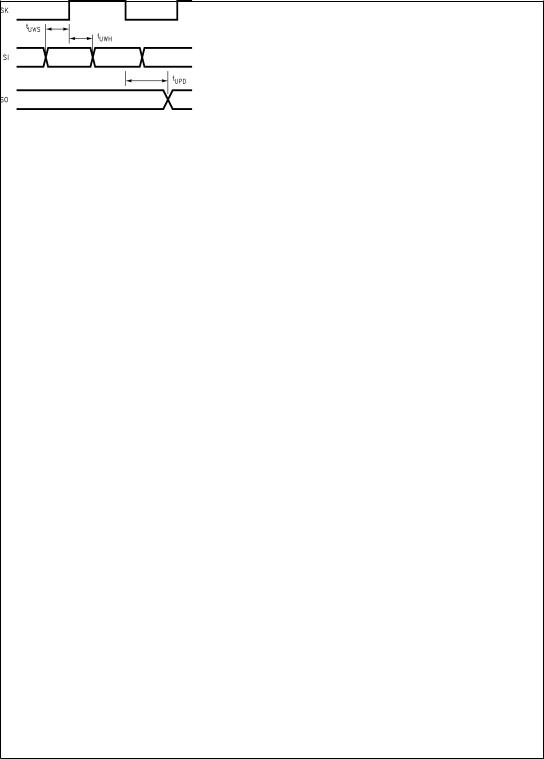
Comparators AC and DC Characteristics
VCC = 5V, −40ÊC ≤ TA ≤ +85ÊC.
Parameter |
Conditions |
Min |
Typ |
Max |
Units |
|
|
|
|
|
|
Input Offset Voltage (Note 12) |
0.4V ≤ VIN ≤ VCC − 1.5V |
|
±5 |
±15 |
mV |
Input Common Mode Voltage Range |
|
0.4 |
|
VCC − 1.5 |
V |
Voltage Gain |
|
|
100 |
|
dB |
|
|
|
|
|
|
Low Level Output Current |
VOL = 0.4V |
−1.6 |
|
|
mA |
High Level Output Current |
VOH = VCC − 0.4V |
1.6 |
|
|
mA |
DC Supply Current per Comparator |
|
|
|
150 |
µA |
(When Enabled) |
|
|
|
|
|
|
|
|
|
|
|
Response Time (Note 13) |
200 mV step input |
|
|
200 |
ns |
|
100 mV Overdrive, |
|
|
||
|
|
|
|
|
|
|
100 pF Load |
|
|
|
|
|
|
|
|
|
|
Note 12: The comparator inputs are high impedance port inputs and, as such, input current is limited to port input leakage current.
Note 13: Response time is measured from a step input to a valid logic level at the comparator output. software response time is dependent of instruction execution.
DS101116-9
FIGURE 4. MICROWIRE/PLUS Timing
9 |
www.national.com |

Typical Performance Characteristics TA = 25ÊC (unless otherwise specified)
DS101116-49 |
DS101116-50 |
DS101116-51 |
DS101116-52 |
www.national.com |
10 |

4.0 Pin Descriptions
The COP8FGx I/O structure enables designers to reconfigure the microcontroller's I/O functions with a single instruction. Each individual I/O pin can be independently configured as output pin low, output high, input with high impedance or input with weak pull-up device. A typical example is the use of I/O pins as the keyboard matrix input lines. The input lines can be programmed with internal weak pull-ups so that the input lines read logic high when the keys are all open. With a key closure, the corresponding input line will read a logic zero since the weak pull-up can easily be overdriven. When the key is released, the internal weak pull-up will pull the input line back to logic high. This eliminates the need for external pull-up resistors. The high current options are available for driving LEDs, motors and speakers. This flexibility helps to ensure a cleaner design, with less external components and lower costs. Below is the general description of all available pins.
VCC and GND are the power supply pins. All VCC and GND pins must be connected.
CKI is the clock input. This can come from the Internal R/C oscillator, external, or a crystal oscillator (in conjunction with CKO). See Oscillator Description section.
RESET is the master reset input. See Reset description section.
Each device contains four bidirectional 8-bit I/O ports (C, G, L and F), where each individual bit may be independently configured as an input (Schmitt trigger inputs on ports L and G), output or TRI-STATE under program control. Three data memory address locations are allocated for each of these I/O ports. Each I/O port has two associated 8-bit memory mapped registers, the CONFIGURATION register and the output DATA register. A memory mapped address is also reserved for the input pins of each I/O port. (See the memory map for the various addresses associated with the I/O ports.) Figure 5 shows the I/O port configurations. The DATA and CONFIGURATION registers allow for each port bit to be individually configured under software control as shown below:
CONFIGURATION |
DATA |
Port Set-Up |
|
Register |
Register |
||
|
|||
|
|
|
|
0 |
0 |
Hi-Z Input |
|
|
|
(TRI-STATE Output) |
|
|
|
|
|
0 |
1 |
Input with Weak Pull-Up |
|
|
|
|
|
1 |
0 |
Push-Pull Zero Output |
|
|
|
|
|
1 |
1 |
Push-Pull One Output |
|
|
|
|
Port L is an 8-bit I/O port. All L-pins have Schmitt triggers on the inputs.
Port L supports the Multi-Input Wake Up feature on all eight pins. Port L has the following alternate pin functions:
L7 Multi-input Wakeup or T3B (Timer T3B Input)
L6 Multi-input Wakeup or T3A (Timer T3A Input)
L5 Multi-input Wakeup or T2B (Timer T2B Input)
L4 Multi-input Wakeup or T2A (Timer T2A Input)
L3 Multi-input Wakeup and/or RDX (USART Receive)
L2 Multi-input Wakeup or TDX (USART Transmit)
L1 Multi-input Wakeup and/or CKX (USART Clock)
L0 Multi-input Wakeup
Port G is an 8-bit port. Pin G0, G2±G5 are bi-directional I/O ports. Pin G6 is always a general purpose Hi-Z input. All pins have Schmitt Triggers on their inputs.Pin G1 serves as the dedicated WATCHDOG output with weak pullup if
WATCHDOG feature is selected by the Mask Option register. The pin is a general purpose I/O if WATCHDOG feature is not selected. If WATCHDOG feature is selected, bit 1 of the Port G configuration and data register does not have any effect on Pin G1 setup. Pin G7 is either input or output depending on the oscillator option selected. With the crystal oscillator option selected, G7 serves as the dedicated output pin for the CKO clock output. With the internal R/C or the external oscillator option selected, G7 serves as a general purpose Hi-Z input pin and is also used to bring the device out of HALT mode with a low to high transition on G7.
Since G6 is an input only pin and G7 is the dedicated CKO clock output pin (crystal clock option) or general purpose input (R/C or external clock option), the associated bits in the data and configuration registers for G6 and G7 are used for special purpose functions as outlined below. Reading the G6 and G7 data bits will return zeroes.
Each device will be placed in the HALT mode by writing a ª1º to bit 7 of the Port G Data Register. Similarly the device will be placed in the IDLE mode by writing a ª1º to bit 6 of the Port G Data Register.
Writing a ª1º to bit 6 of the Port G Configuration Register enables the MICROWIRE/PLUS to operate with the alternate phase of the SK clock. The G7 configuration bit, if set high, enables the clock start up delay after HALT when the R/C clock configuration is used.
|
Config. Reg. |
Data Reg. |
|
|
|
G7 |
CLKDLY |
HALT |
|
|
|
G6 |
Alternate SK |
IDLE |
|
|
|
Port G has the following alternate features:
G7 CKO Oscillator dedicated output or general purpose input
G6 SI (MICROWIRE Serial Data Input)
G5 SK (MICROWIRE Serial Clock)
G4 SO (MICROWIRE Serial Data Output)
G3 T1A (Timer T1 I/O)
G2 T1B (Timer T1 Capture Input)
G1 WDOUT WATCHDOG and/or CLock Monitor if WATCHDOG enabled, otherwise it is a general purpose I/O
G0 INTR (External Interrupt Input)
Port C is an 8-bit I/O port. The 40-pin device does not have a full complement of Port C pins. The unavailable pins are not terminated. A read operation on these unterminated pins will return unpredictable values. The 28 pin device do not offer Port C. On this device, the associated Port C Data and Configuration registers should not be used.
Port F is an 8-bit I/O port. The 28--pin device does not have a full complement of Port F pins. The unavailable pins are not terminated. A read operation on these unterminated pins will return unpredictable values.
Port F1±F3 are used for Comparator 1. Port F4±F6 are used for Comparator 2.
The Port F has the following alternate features:
F6 COMP2OUT (Comparator 2 Output)
F5 COMP2+IN (Comparator 2 Positive Input)
F4 COMP2-IN (Comparator 2 Negative Input)
F3 COMP1OUT (Comparator 1 Output)
F2 COMP1+IN (Comparator 1 Positive Input)
F1 COMP1-IN (Comparator 1 Negative Input)
Note: For compatibility with existing software written for COP888xG devices and with existing Mask ROM devices, a read of the Port I input pins
11 |
www.national.com |
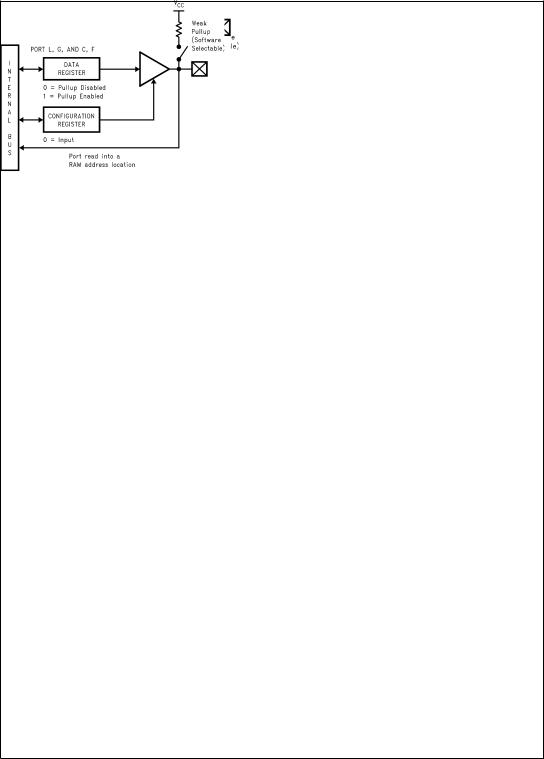
4.0 Pin Descriptions (Continued)
(address xxD7) will return the same data as reading the Port F input pins (address xx96). It is recommended new applications which will go to production with the COP8FGx use the Port F addresses. Note that compatible ROM devices contains the input only Port I instead of the bi-directional Port F.
Port D is an 8-bit output port that is preset high when RESET goes low. The user can tie two or more D port outputs (except D2) together in order to get a higher drive.
Note: Care must be exercised with the D2 pin operation. At RESET, the external loads on this pin must ensure that the output voltages stay above 0.7 VCC to prevent the chip from entering special modes. Also keep the external loading on D2 to less than 1000 pF.
DS101116-10
FIGURE 5. I/O Port Configurations
DS101116-12
FIGURE 6. I/O Port Configurations Ð Output Mode
DS101116-11
FIGURE 7. I/O Port Configurations Ð Input Mode
5.0 Functional Description
The architecture of the devices are a modified Harvard architecture. With the Harvard architecture, the program memory ROM is separated from the data store memory (RAM). Both ROM and RAM have their own separate addressing space with separate address buses. The architecture, though based on the Harvard architecture, permits transfer of data from ROM to RAM.
5.1 CPU REGISTERS
The CPU can do an 8-bit addition, subtraction, logical or shift operation in one instruction (tC) cycle time.
There are six CPU registers:
A is the 8-bit Accumulator Register
PC is the 15-bit Program Counter Register
PU is the upper 7 bits of the program counter (PC)
PL is the lower 8 bits of the program counter (PC)
B is an 8-bit RAM address pointer, which can be optionally post auto incremented or decremented.
X is an 8-bit alternate RAM address pointer, which can be optionally post auto incremented or decremented.
S is the 8-bit Segment Address Register used to extend the lower half of the address range (00 to 7F) into 256 data segments of 128 bytes each.
SP is the 8-bit stack pointer, which points to the subroutine/ interrupt stack (in RAM). With reset the SP is initialized to RAM address 02F Hex (devices with 64 bytes of RAM), or initialized to RAM address 06F Hex (devices with 128 bytes of RAM).
All the CPU registers are memory mapped with the exception of the Accumulator (A) and the Program Counter (PC).
5.2 PROGRAM MEMORY
The program memory consists of varies sizes of ROM. These bytes may hold program instructions or constant data (data tables for the LAID instruction, jump vectors for the JID instruction, and interrupt vectors for the VIS instruction). The program memory is addressed by the 15-bit program counter (PC). All interrupts in the device vector to program memory location 0FF Hex. The contents of the program memory read 00 Hex in the erased state. Program execution starts at location 0 after RESET.
5.3 DATA MEMORY
The data memory address space includes the on-chip RAM and data registers, the I/O registers (Configuration, Data and Pin), the control registers, the MICROWIRE/PLUS SIO shift register, and the various registers, and counters associated with the timers (with the exception of the IDLE timer). Data memory is addressed directly by the instruction or indirectly by the B, X and SP pointers.
The data memory consists of 256 or 512 bytes of RAM. Sixteen bytes of RAM are mapped as ªregistersº at addresses 0F0 to 0FE Hex. These registers can be loaded immediately, and also decremented and tested with the DRSZ (decrement register and skip if zero) instruction. The memory pointer registers X, SP and B are memory mapped into this space at address locations 0FC to 0FE Hex respectively, with the other registers (except 0FF) being available for general usage.
The instruction set permits any bit in memory to be set, reset or tested. All I/O and registers (except A and PC) are
www.national.com |
12 |
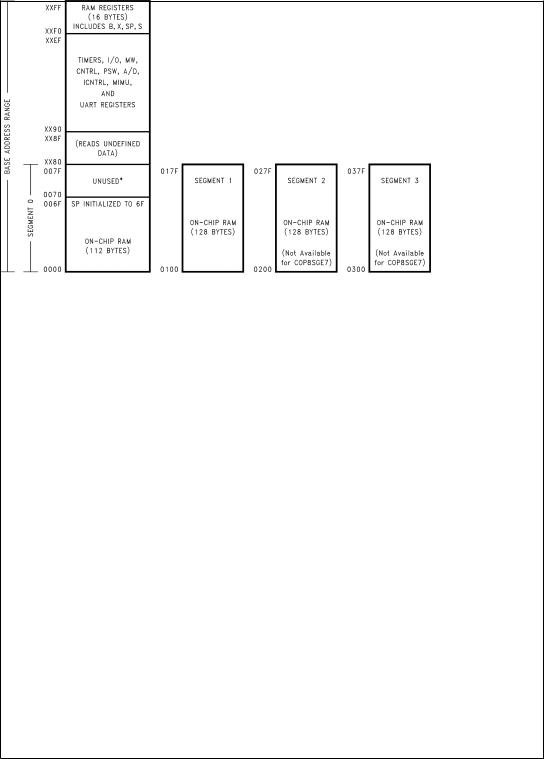
5.0 Functional Description (Continued)
memory mapped; therefore, I/O bits and register bits can be directly and individually set, reset and tested. The accumulator (A) bits can also be directly and individually tested.
Note: RAM contents are undefined upon power-up.
5.4 DATA MEMORY SEGMENT RAM EXTENSION
Data memory address 0FF is used as a memory mapped location for the Data Segment Address Register (S).
The data store memory is either addressed directly by a single byte address within the instruction, or indirectly relative to the reference of the B, X, or SP pointers (each contains a single-byte address). This single-byte address allows an addressing range of 256 locations from 00 to FF hex. The upper bit of this single-byte address divides the data store memory into two separate sections as outlined previously. With the exception of the RAM register memory from address locations 00F0 to 00FF, all RAM memory is memory mapped with the upper bit of the single-byte address being equal to zero. This allows the upper bit of the single-byte address to determine whether or not the base address range (from 0000 to 00FF) is extended. If this upper bit equals one (representing address range 0080 to 00FF), then address
extension does not take place. Alternatively, if this upper bit equals zero, then the data segment extension register S is used to extend the base address range (from 0000 to 007F) from XX00 to XX7F, where XX represents the 8 bits from the S register. Thus the 128-byte data segment extensions are located from addresses 0100 to 017F for data segment 1, 0200 to 027F for data segment 2, etc., up to FF00 to FF7F for data segment 255. The base address range from 0000 to 007F represents data segment 0.
Figure 8 illustrates how the S register data memory extension is used in extending the lower half of the base address range (00 to 7F hex) into 256 data segments of 128 bytes each, with a total addressing range of 32 kbytes from XX00 to XX7F. This organization allows a total of 256 data segments of 128 bytes each with an additional upper base segment of 128 bytes. Furthermore, all addressing modes are available for all data segments. The S register must be changed under program control to move from one data segment (128 bytes) to another. However, the upper base segment (containing the 16 memory registers, I/O registers, control registers, etc.) is always available regardless of the contents of the S register, since the upper base segment (address range 0080 to 00FF) is independent of data segment extension.
DS101116-45
FIGURE 8. RAM Organization
The instructions that utilize the stack pointer (SP) always reference the stack as part of the base segment (Segment 0), regardless of the contents of the S register. The S register is not changed by these instructions. Consequently, the stack (used with subroutine linkage and interrupts) is always located in the base segment. The stack pointer will be initialized to point at data memory location 006F as a result of reset.
The 128 bytes of RAM contained in the base segment are split between the lower and upper base segments. The first 112 bytes of RAM are resident from address 0000 to 006F in the lower base segment, while the remaining 16 bytes of
RAM represent the 16 data memory registers located at addresses 00F0 to 00FF of the upper base segment. No RAM is located at the upper sixteen addresses (0070 to 007F) of the lower base segment.
Additional RAM beyond these initial 128 bytes, however, will always be memory mapped in groups of 128 bytes (or less) at the data segment address extensions (XX00 to XX7F) of the lower base segment. The additional 384 bytes of RAM in this device are memory mapped at address locations 0100 to 017F, 0200 to 027F and 0300 to 037F hex.
13 |
www.national.com |
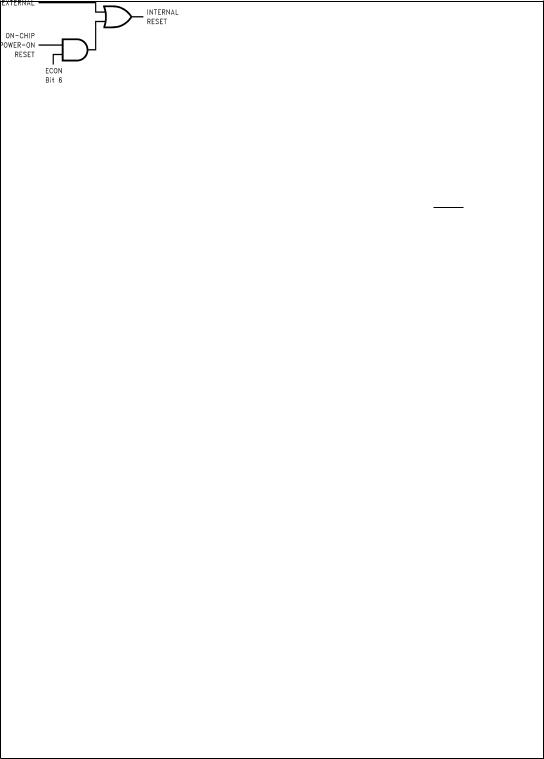
5.0 Functional Description (Continued)
Memory address ranges 0200 to 027F and 0300 to 037F are unavailable on the COP8FGx5 and, if read, will return underfined data.
5.5 ECON (CONFIGURATION) REGISTER
For compatibility with COP8FGx7 devices, mask options are defined by an ECON Configuration Register which is programmed at the same time as the program code. Therefore, the register is programmed at the same time as the program memory.
The format of the ECON register is as follows:
Bit 7 |
Bit 6 |
Bit 5 |
Bit 4 |
Bit 3 |
Bit 2 |
Bit 1 |
Bit 0 |
|
|
|
|
|
|
|
|
X |
POR |
SECURITY |
CKI 2 |
CKI 1 |
WATCH |
F-Port |
HALT |
|
|
|
|
|
DOG |
|
|
|
|
|
|
|
|
|
|
Bit 7 |
= x |
This is for factory test. The polarity is ªDon't |
|||||
|
|
Care.º |
|
|
|
|
|
Bit 6 |
= 1 |
Power-on reset enabled. |
|
|
|||
= 0 Power-on reset disabled.
Bit 5 = 1 |
Security enabled. |
Bits 4, 3 = 0, 0 External CKI option selected. G7 is available as a HALT restart and/or general purpose input. CKI is clock input.
=0, 1 R/C oscillator option selected. G7 is available as a HALT restart and/or general purpose input. CKI clock input. Internal R/C components are supplied for maximum R/C frequency.
=1, 0 Crystal oscillator with on-chip crystal bias resistor disabled. G7 (CKO) is the clock generator output to crystal/resonator.
=1, 1 Crystal oscillator with on-chip crystal bias resistor enabled. G7 (CKO) is the clock generator output to crystal/resonator.
Bit 2 |
= 1 |
WATCHDOG feature disabled. G1 is a gen- |
|
|
eral purpose I/O. |
|
= 0 |
WATCHDOG feature enabled. G1 pin is |
|
|
WATCHDOG output with weak pullup. |
Bit 1 |
= 1 |
Force port I compatibility. Disable port F |
|
|
outputs and pull-ups. This is intended for |
|
|
compatibility with existing code and Mask |
|
|
ROMMed devices only. This bit should be |
|
|
programmed to 0 for all other applications. |
|
= 0 |
Enable full port F capability. |
Bit 0 |
= 1 |
HALT mode disabled. |
=0 HALT mode enabled.
5.6USER STORAGE SPACE IN EPROM
The ECON register is outside of the normal address range of the ROM and can not be accessed by the executing software.
The COP8 assembler defines a special ROM section type, CONF, into which the ECON may be coded. Both ECON and User Data are programmed automatically by programmers that are certified by National.
The following examples illustrate the declaration of ECON and the User information.
Syntax: |
|
[label:] .sect |
econ, conf |
.db |
value ;1 byte, |
|
;configures options |
.db |
<user information> |
.endsect |
; up to 8 bytes |
Example: The following sets a value in the ECON register and User Identification for a COP8FGR728M7. The ECON bit values shown select options: Power-on enabled, Security disabled, Crystal oscillator with on-chip bias disabled, WATCHDOG enabled and HALT mode enabled.
.sect |
econ, conf |
|
|
.db |
0x55 |
;por, |
xtal, wd, halt |
.db |
©my v1.00© |
;user |
data declaration |
.endsect
5.7 RESET
The devices are initialized when the RESET pin is pulled low or the On-chip Power-On Reset is enabled.
DS101116-13
FIGURE 9. Reset Logic
The following occurs upon initialization:
Port L: TRI-STATE (High Impedance Input)
Port C: TRI-STATE (High Impedance Input)
Port G: TRI-STATE (High Impedance Input)
Port F: TRI-STATE (High Impedance Input)
Port D: HIGH
PC: CLEARED to 0000
PSW, CNTRL and ICNTRL registers: CLEARED SIOR:
UNAFFECTED after RESET with power already applied RANDOM after RESET at power-on
T2CNTRL: CLEARED
T3CNTRL: CLEARED
Accumulator, Timer 1, Timer 2 and Timer 3: RANDOM after RESET with crystal clock option (power already applied)
UNAFFECTED after RESET with R/C clock option (power already applied)
RANDOM after RESET at power-on
WKEN, WKEDG: CLEARED
WKPND: RANDOM
SP (Stack Pointer):
Initialized to RAM address 06F Hex
B and X Pointers:
UNAFFECTED after RESET with power already applied RANDOM after RESET at power-on
S Register: CLEARED
www.national.com |
14 |
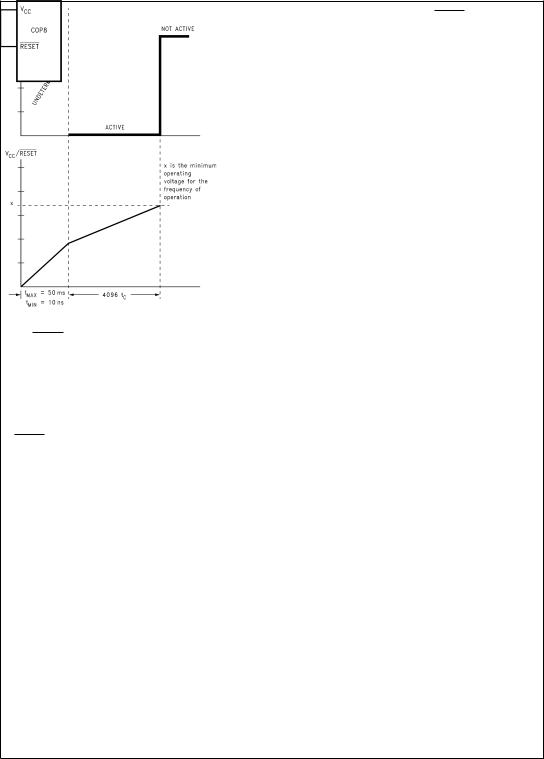
5.0 Functional Description (Continued)
RAM:
UNAFFECTED after RESET with power already applied
RANDOM after RESET at power-on
USART:
PSR, ENU, ENUR, ENUI: Cleared except the TBMT bit
which is set to one.
COMPARATORS:
CMPSL; CLEARED
WATCHDOG (if enabled):
The device comes out of reset with both the WATCHDOG logic and the Clock Monitor detector armed, with the WATCHDOG service window bits set and the Clock Monitor bit set. The WATCHDOG and Clock Monitor circuits are inhibited during reset. The WATCHDOG service window bits being initialized high default to the maximum WATCHDOG service window of 64k tC clock cycles. The Clock Monitor bit being initialized high will cause a Clock Monitor error following reset if the clock has not reached the minimum specified frequency at the termination of reset. A Clock Monitor error will cause an active low error output on pin G1. This error output will continue until 16 tC±32 tC clock cycles following the clock frequency reaching the minimum specified value, at which time the G1 output will go high.
5.7.1 External Reset
The RESET input when pulled low initializes the device. The RESET pin must be held low for a minimum of one instruction cycle to guarantee a valid reset. During Power-Up initialization, the user must ensure that the RESET pin is held low until the device is within the specified VCC voltage. An R/C circuit on the RESET pin with a delay 5 times (5x) greater than the power supply rise time or 15 µs whichever is greater, is recommended. Reset should also be wide enough to ensure crystal start-up upon Power-Up.
RESET may also be used to cause an exit from the HALT mode.
A recommended reset circuit for this device is shown in Figure 10.
Under no circumstances should the RESET pin be allowed to float. If the on-chip Power-On Reset feature is being used, RESET pin should be connected directly to VCC. The output of the power-on reset detector will always preset the Idle timer to 0FFF(4096 tC). At this time, the internal reset will be generated.
If the Power-On Reset feature is enabled, the internal reset will not be turned off until the Idle timer underflows. The internal reset will perform the same functions as external reset. The user is responsible for ensuring that VCC is at the minimum level for the operating frequency within the 4096 tC. After the underflow, the logic is designed such that no additional internal resets occur as long as VCC remains above 2.0V.
The contents of data registers and RAM are unknown following the on-chip reset.
DS101116-14
RC >5x power supply rise time or 15 µs, whichever is greater.
FIGURE 10. Reset Circuit Using External Reset
5.7.2 On-Chip Power-On Reset
The on-chip reset circuit is selected by a bit in the ECON register. When enabled, the device generates an internal reset as VCC rises to a voltage level above 2.0V. The on-chip reset circuitry is able to detect both fast and slow rise times on VCC (VCC rise time between 10 ns and 50 ms).To guarantee an on-chip power-on-reset, VCCmust start at a voltage less than the start voltage specified in the DC characteristics. Also, if VCC be lowered to the start voltage before powering back up to the operating range. If this is not possible, it is recommended that external reset be used.
DS101116-15
FIGURE 11. Reset Timing (Power-On Reset Enabled) with VCC Tied to RESET
DS101116-16
FIGURE 12. Reset Circuit Using Power-On Reset
15 |
www.national.com |

5.0 Functional Description (Continued)
5.8 OSCILLATOR CIRCUITS
There are four clock oscillator options available: Crystal Oscillator with or without on-chip bias resistor, R/C Oscillator with on-chip resistor and capacitor, and External Oscillator. The oscillator feature is selected by programming the ECON register, which is summarized in Table 1.
TABLE 1. Oscillator Option
ECON4 |
ECON3 |
Oscillator Option |
|
|
|
0 |
0 |
External Oscillator |
|
|
|
1 |
0 |
Crystal Oscillator without Bias Resistor |
|
|
|
0 |
1 |
R/C Oscillator |
|
|
|
1 |
1 |
Crystal Oscillator with Bias Resistor |
|
|
|
5.8.1 Crystal Oscillator
The crystal Oscillator mode can be selected by programming ECON Bit 4 to 1. CKI is the clock input while G7/CKO is the clock generator output to the crystal. An on-chip bias resistor connected between CKI and CKO can be enabled by programming ECON Bit 3 to 1 with the crystal oscillator option selection. The value of the resistor is in the range of 0.5M to 2M (typically 1.0M). Table 2 shows the component values required for various standard crystal values. Resistor R2 is only used when the on-chip bias resistor is disabled. Figure 13 shows the crystal oscillator connection diagram.
TABLE 2. Crystal Oscillator Configuration,
TA = 25ÊC, VCC = 5V
R1 (kΩ) |
R2 (MΩ) |
C1 (pF) |
C2 (pF) |
CKI Freq. |
|
(MHz) |
|||||
|
|
|
|
||
|
|
|
|
|
|
0 |
1 |
18 |
18 |
15 |
|
|
|
|
|
|
|
0 |
1 |
20 |
20 |
10 |
|
|
|
|
|
|
|
0 |
1 |
25 |
25 |
4 |
|
|
|
|
|
|
|
5.6 |
1 |
100 |
100±156 |
0.455 |
|
|
|
|
|
|
With On-Chip Bias Resistor
5.8.2 External Oscillator
The External Oscillator mode can be selected by programming ECON Bit 3 to 0 and ECON Bit 4 to 0. CKI can be driven by an external clock signal provided it meets the specified duty cycle, rise and fall times, and input levels. G7/ CKO is available as a general purpose input G7 and/or Halt control. Figure 14 shows the external oscillator connection diagram.
5.8.3 R/C Oscillator
The R/C Oscillator mode can be selected by programming ECON Bit 3 to 1 and ECON Bit 4 to 0. In R/C oscillation mode, CKI is left floating, while G7/CKO is available as a general purpose input G7 and/or HALT control. The R/C controlled oscillator has on-chip resistor and capacitor for maximum R/C oscillator frequency operation. The maximum frequency is 5 MHz ± 35% for VCC between 4.5V to 5.5V and temperature range of −40ÊC to +85ÊC. For max frequency operation, the CKI pin should be left floating. For lower frequencies, an external capacitor should be connected between CKI and either VCC or GND. Immunity of the R/C oscillator to external noise can be improved by connecting one half the external capacitance to VCC and one half to GND. PC board trace length on the CKI pin should be kept as short as possible. Table 3 shows the oscillator frequency as a function of external capacitance on the CKI pin. Figure 15 shows the R/C oscillator configuration.
TABLE 3. R/C Oscillator Configuration, −40ÊC to +85ÊC, V CC = 4.5V to 5.5V,
OSC Freq. Variation of ± |
35% |
||
|
|
|
|
External |
R/C OSC Freq |
|
Instr. Cycle |
Capacitor (pF)* |
(MHz) |
|
(µs) |
|
|
|
|
0 |
5 |
|
2.0 |
|
|
|
|
9 |
4 |
|
2.5 |
|
|
|
|
52 |
2 |
|
5.0 |
|
|
|
|
125 |
1 |
|
10 |
|
|
|
|
6100 |
32 kHz |
|
312.5 |
|
|
|
|
* Assumes 3-5 pF board capacitance.
Without On-Chip Bias Resistor
DS101116-17 |
DS101116-18 |
FIGURE 13. Crystal Oscillator
www.national.com |
16 |

5.0 Functional Description (Continued)
DS101116-19
FIGURE 14. External Oscillator
DS101116-20
For operation at lower than maximum R/C oscillator frequency.
DS101116-21
For operation at maximum R/C oscillator frequency.
FIGURE 15. R/C Oscillator
17 |
www.national.com |

5.0 Functional Description (Continued)
5.9 CONTROL REGISTERS
CNTRL Register (Address X©00EE)
T1C3 |
T1C2 |
T1C1 |
T1C0 |
MSEL |
IEDG |
SL1 |
SL0 |
|
|
|
|
|
|
|
|
Bit 7 |
Bit 0 |
||||||
|
|
|
|
|
|
|
|
The Timer1 (T1) and MICROWIRE/PLUS control register contains the following bits:
T1C3 |
Timer T1 mode control bit |
T1C2 |
Timer T1 mode control bit |
T1C1 |
Timer T1 mode control bit |
T1C0 |
Timer T1 Start/Stop control in timer |
|
modes 1 and 2, T1 Underflow Interrupt |
|
Pending Flag in timer mode 3 |
MSEL |
Selects G5 and G4 as MICROWIRE/PLUS |
|
signals SK and SO respectively |
IEDG |
External interrupt edge polarity select |
|
(0 = Rising edge, 1 = Falling edge) |
SL1 & SL0 |
Select the MICROWIRE/PLUS clock divide |
|
by (00 = 2, 01 = 4, 1x = 8) |
PSW Register (Address X©00EF)
HC |
C |
T1PNDA |
T1ENA |
EXPND |
BUSY |
EXEN |
GIE |
|
|
|
|
|
|
|
|
Bit 7 |
|
|
|
|
|
|
Bit 0 |
|
|
|
|
|
|
|
|
The PSW register contains the following select bits:
HC |
Half Carry Flag |
C |
Carry Flag |
T1PNDA Timer T1 Interrupt Pending Flag (Autoreload RA in mode 1, T1 Underflow in Mode 2, T1A capture edge in mode 3)
T1ENA |
Timer T1 Interrupt Enable for Timer Underflow |
|
or T1A Input capture edge |
EXPND |
External interrupt pending |
BUSY |
MICROWIRE/PLUS busy shifting flag |
EXEN |
Enable external interrupt |
GIE |
Global interrupt enable (enables interrupts) |
The Half-Carry flag is also affected by all the instructions that affect the Carry flag. The SC (Set Carry) and R/C (Reset Carry) instructions will respectively set or clear both the carry flags. In addition to the SC and R/C instructions, ADC, SUBC, RRC and RLC instructions affect the Carry and Half Carry flags.
ICNTRL Register (Address X©00E8)
Reserved |
LPEN |
T0PND |
T0EN |
µWPND |
µWEN |
T1PNDB |
T1ENB |
|
|
|
|
|
|
|
|
|
|
|
|
Bit 7 |
|
|
|
|
|
|
Bit 0 |
|
|
|
|
|
|
|
|
|
|
|
|
The ICNTRL register contains the following bits: |
|||||||||
Reserved |
This bit is reserved and must be zero |
||||||||
LPEN |
L Port Interrupt Enable (Multi-Input Wakeup/ |
||||||||
|
|
Interrupt) |
|||||||
T0PND |
Timer T0 Interrupt pending |
||||||||
T0EN |
Timer T0 Interrupt Enable (Bit 12 toggle) |
||||||||
µWPND |
MICROWIRE/PLUS interrupt pending |
||||||||
µWEN |
Enable MICROWIRE/PLUS interrupt |
||||||||
T1PNDB |
Timer T1 Interrupt Pending Flag for T1B cap- |
||||||||
|
|
ture edge |
|||||||
T1ENB |
Timer T1 Interrupt Enable for T1B Input cap- |
||||||
|
|
ture edge |
|||||
T2CNTRL Register (Address X©00C6) |
|||||||
|
|
|
|
|
|
|
|
T2C3 |
T2C2 |
T2C1 |
T2C0 |
T2PNDA |
T2ENA |
T2PNDB |
T2ENB |
|
|
|
|
|
|
|
|
Bit 7 |
|
|
|
|
|
Bit 0 |
|
|
|
|
|
|
|
|
|
The T2CNTRL control register contains the following bits:
T2C3 Timer T2 mode control bit
T2C2 Timer T2 mode control bit
T2C1 Timer T2 mode control bit
T2C0 |
Timer |
T2 |
Start/Stop control in |
timer |
|||
|
|
modes 1 and 2, T2 Underflow Interrupt Pend- |
|||||
|
|
ing Flag in timer mode 3 |
|
||||
T2PNDA |
Timer T2 Interrupt Pending Flag (Autoreload |
||||||
|
|
RA in mode 1, T2 Underflow in mode 2, T2A |
|||||
|
|
capture edge in mode 3) |
|
||||
T2ENA |
Timer T2 Interrupt Enable for Timer Underflow |
||||||
|
|
or T2A Input capture edge |
|
||||
T2PNDB |
Timer T2 Interrupt Pending Flag for T2B cap- |
||||||
|
|
ture edge |
|
|
|
|
|
T2ENB |
Timer T2 Interrupt Enable for Timer Underflow |
||||||
|
|
or T2B Input capture edge |
|
||||
T3CNTRL Register (Address X©00B6) |
|
||||||
|
|
|
|
|
|
|
|
T3C3 |
T3C2 |
T3C1 |
T3C0 |
T3PNDA |
T3ENA |
T3PNDB |
T3ENB |
|
|
|
|
|
|
|
|
Bit 7 |
|
|
|
|
|
Bit 0 |
|
|
|
|
|
|
|
|
|
The T3CNTRL control register contains the following bits:
T3C3 |
Timer T3 mode control bit |
T3C2 |
Timer T3 mode control bit |
T3C1 |
Timer T3 mode control bit |
T3C0 |
Timer T3 Start/Stop control in timer |
|
modes 1 and 2, T3 Underflow Interrupt Pend- |
|
ing Flag in timer mode 3 |
T3PNDA |
Timer T3 Interrupt Pending Flag (Autoreload |
|
RA in mode 1, T3 Underflow in mode 2, T3A |
|
capture edge in mode 3) |
T3ENA |
Timer T3 Interrupt Enable for Timer Underflow |
|
or T3A Input capture edge |
T3PNDB |
Timer T3 Interrupt Pending Flag for T3B cap- |
|
ture edge |
T3ENB |
Timer T3 Interrupt Enable for Timer Underflow |
|
or T3B Input capture edge |
6.0 Timers
Each device contains a very versatile set of timers (T0, T1, T2 and T3). Timer T1, T2 and T3 and associated autoreload/ capture registers power up containing random data.
6.1 TIMER T0 (IDLE TIMER)
Each device supports applications that require maintaining real time and low power with the IDLE mode. This IDLE mode support is furnished by the IDLE timer T0. The Timer T0 runs continuously at the fixed rate of the instruction cycle clock, tC. The user cannot read or write to the IDLE Timer T0, which is a count down timer.
The Timer T0 supports the following functions:
·Exit out of the Idle Mode (See Idle Mode description)
·WATCHDOG logic (See WATCHDOG description)
·Start up delay out of the HALT mode
www.national.com |
18 |
